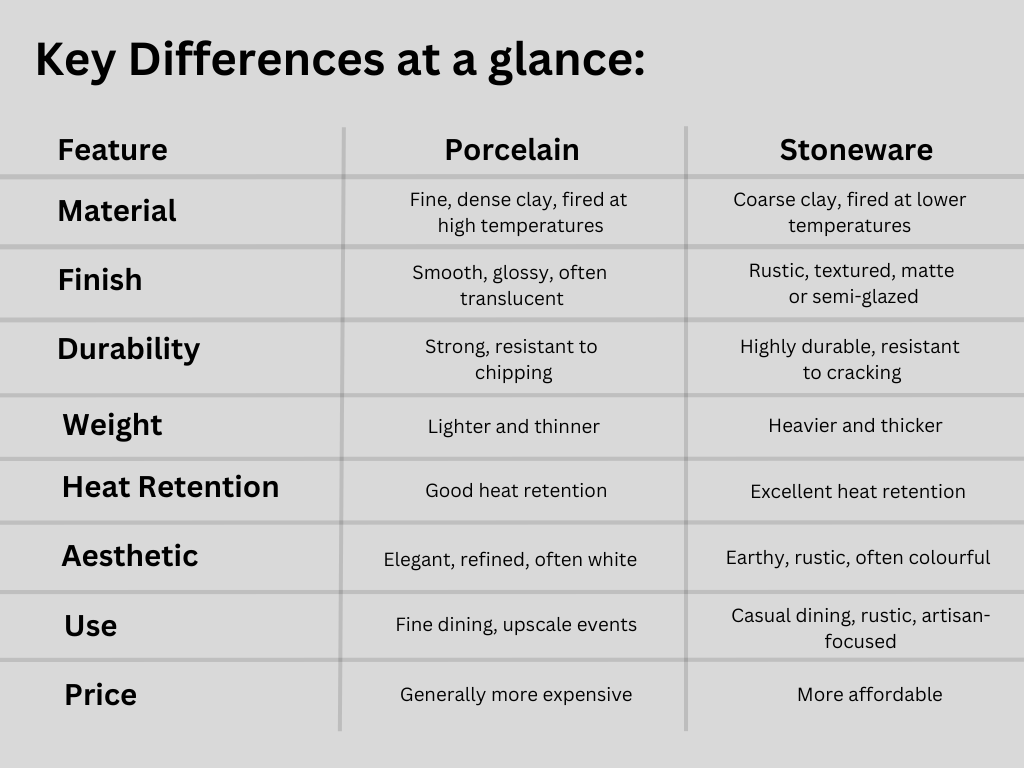Porcelain Vs Stoneware: Which is best for your kitchen?
What's the difference between Porcelain and Stoneware?
At a glance, porcelain and stoneware may look similar, but they differ significantly in terms of materials, appearance, and performance.
Porcelain
Porcelain is a type of ceramic made from fine clay, fired at a high temperature (typically over 1200°C). This process creates a smooth, dense, and translucent material that is both strong and elegant. Porcelain has a refined finish that is often associated with fine dining. It's typically white or light in colour but can be glazed to suit different styles.
Porcelain is known for its resistance to chipping, it can withstand the harshness of a busy kitchen without losing its appeal.Due to its density, porcelain retains heat well, ensuring that dishes stay warmer longer during services
The glossy, refined finish of porcelain gives it a premium look, perfect for upscale restaurants, fine dining, or catered events where presentation is key.
Available in various shapes, sizes and styles, porcelain is highly versatile and works across all types of cuisines.
Porcelain is ideal for fine dining establishments, hotels, or events where presentation is paramount. It's also an excellent choice for dishes that require a smooth surface, like sushi plates or delicate desserts, as its glossy finish adds a touch of sophistication.
Stoneware
Stoneware, on the other hand, is made from coarse clay, fired at a lower temperature of (around 1000°C). The result is a more rustic clay, earthy finish. Stoneware tends to be heavier and thicker than porcelain and often has a more textures surface. It can come in a variety of colours and finishes, but it's typically matte or semi-glazed, offering a more casual, artisanal feel.
Stoneware is tough and durable, making it a great choice for busy kitchens where crockery is in constant use. It's resistant to cracking can withstand higher temperatures.
The earthy tones and natural textures of stoneware lend themselves to a more rustic, honey aesthetic. This can be particularly effective in casual dining or farm-to-table restaurants that emphasise organic, handcrafted experiences.
Stoneware can often be used in the oven or microwave, making it versatile for both cooking and serving. It's great for dishes that require extra heating or finishing before serving.
Generally, stoneware tends to be more affordable than porcelain, making it a great option for those on a budget but who still want sturdy, attractive tableware.
Stoneware is ideal for casual dining establishments, gastro pubs, or any setting where a more relaxed atmosphere is desired. It's great for dishes that require rustic, hearty presentation like stews, casseroles, or salads, and can add a charm to buffet-style service or shared platters.

Which is Right for Your Kitchen?
When deciding between porcelain and stoneware, think about your restaurant's concept, the type of food you serve, and the kind of dining experience you want to create.
Choose porcelain for a clean, polished look that elevates the dining experience. It's the best choice for fine dining, banquet services, and gourmet cuisine where tableware is part of the visual appeal.
Opt for stoneware if you want a more rustic feel. It's perfect for farm-to-table menus, gastropubs, or eateries that prioritise a warm, homey atmosphere.
Both porcelain and stoneware have their place in professional kitchens. By understanding the benefits and characteristics of each, you can select the right tableware to enhance the dining experience and suit the demands of your kitchen. So, whether you're after the elegance of porcelain or the rustic charm of stoneware, make sure your choice complements your menu and your restaurant's atmosphere.
Ready to upgrade your tableware? Explore our collection at Russums, where we bring you top-quality products to support your culinary creativity.
3 February 2025





